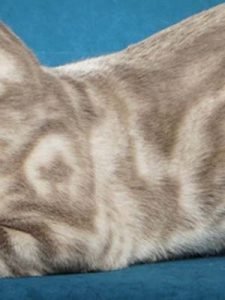Bengal Info
The Bengal breed originated as a cross between the Asian Leopard cat (Prionailurus Bengalensis) and a Domestic cat. The first three generations of a domestic bengal X Leopard cat are called foundations (F1, F2, and F3). The fourth generation and any beyond that are called Bengals (also refered to as SBT). The Bengal cat is a domestic cat, yet has retained some of its wild characteristics. They are very athletic and enjoy climbing to high places. Bengals also have a fascination with water and will take any opportunity to play in it.
The Bengal cat has a very soft short to medium coat that is slightly longer in kittens. It is thick and luxurious and comes in various colors and patterns such as rosettes, spots and marbles. Some have glittered coats (as if gold dust were sprinkled over them) which is a very desirable quality. They have large alert eyes and they are very curious. The Bengal cat makes a great family pet. They get along great with their family as well with the family dog.
Bengals are very active cats, especially when they are kittens. They are very inquisitive and like to explore anything they can access. This usually involves things getting chewed or broken if you haven’t kitten-proofed your home (which is highly recommended if you don’t want things destroyed). They do slow down somewhat once they hit adulthood, so don’t worry, you wont have to deal with this craziness forever 😉
If you have any questions, please read through my Frequently Asked Questions page before emailing me 🙂
Health Concerns
Other health issues are PK Deficiency (a type of anemia), and PRA (Progressive Retinal Atrophy) which can cause early blindness. Our cats are all tested for both of these health problems and cannot produce kittens that are positive for these diseases. We may have the occasional female that is a carrier of one disease (N/K), however we always ensure that all of our studs are negative so that they cannot produce kittens with the disease. Being a carrier does not affect the kittens health in any way.
Coat Patterns
Coat Patterns

Arrowhead
Arrowhead rosette markings should be triangular in shape pointing toward the back of the body with the base of the rosette fading into the background.
Available
Bengal Cats
For more info email us at marla@lonestarbengals.com to request my questionnaire to learn more about each other before approval
